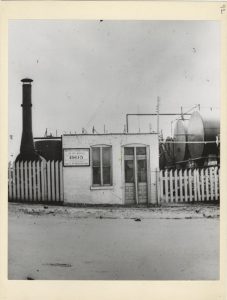News
August 6, 2024 | Insights
A Brief Account of the Beginning of Gas Stations and Convenience Stores
By Sutton Wester, Senior Associate
North of Chouteau on Theresa Avenue in St. Louis: the birthplace of the gas station. In 1905, Harry Grenner and Clem Laessig opened the first drive-in filling station for motorists, consisting of a gravity-fed tank with what looked like a rudimentary garden hose attached to its base.1 When a customer drove in to refuel, an employee placed the hose into the fuel tank, opened the spigot, and let gravity push fuel directly into the motorcar.2 Magic, compared to the ways of old. Grenner and Laessig started as bulk fuel distributors (the old way) but thought it would be more profitable if motorists could buy gasoline in a quick, efficient way.3 They were right: their company, Automobile Gasoline Company, went on to operate more than 40 gas stations in St. Louis.4

As a St. Louis resident for much of my life and working in the retail gas and convenience space, this fact delights me. How many times had I driven on Chouteau, the old Route 66, and unknowingly passed the site of Grenner and Laessig’s revolutionary idea? The station sold nothing but gasoline, but the foundation for gas stations as we know them today was built by a desire to improve a cumbersome, dangerous task into something more…convenient.
In the early 1900s, Americans began to rely on perishable goods as they moved to cities and farther away from food sources. To combat this, they purchased blocks of ice to refrigerate food at home. Ice companies were considered public utilities—an essential good—with the increased need for refrigeration. Southland Ice Company operated ice plants and retail ice docks throughout Dallas and San Antonio. Unlike local grocery stores, ice docks operated 16 hours a day (7:00 am to 11:00 pm), seven days a week.5 Jefferson Green, operator of one Southland ice dock in Dallas, thought, “why not sell milk, bread, and eggs, too?”6 So in 1927, he did just that. Company execs saw potential in the idea and began selling grocery items at all Southland ice docks. In 1946, the company rebranded to 7-Eleven to reflect its long operating hours.7 Store location and format allowed a natural expansion to offer fuel in the 1950s. 7-Eleven embodied the one-stop shop, providing consumers with everything they needed.
Automobile Gasoline Company and its novel way of fueling propelled consumer confidence in the motorcar. Car ownership became accessible to the masses when they could refuel in a safe manner anywhere. Similarly, Southland Ice Company disrupted the grocery market. 7-Eleven combined Grenner and Laessig’s drive-in filling station with Southland Ice Company’s retail grocery model. The complimentary pivot gave consumers flexibility, optionality, and most importantly, time.
Today, there are over 152,000 convenience stores operating in the United States.8 Location, extended hours of operation, and sheer volume makes the convenience store an integral part of the American consumer’s life, with nearly half of the population stopping in to refuel, grab a bite, or use the restroom daily.9
Notes
1 Sonderman, Joseph R. Route 66 St. Louis Style. Arcadia Publishing Inc., 18 September 2023.
2 Witzel, Michael Karl. Route 66 Remembered. Motorbooks International, 1 January 2003.
3 Preservation Eastern, “Preservation Eastern Newsletter, November 1997” (1997). Post & Lintel. Paper 15.
4 Sonderman. Route 66 St. Louis Style.
5 Madan, Rajni. “Southland Corporation.” Texas State Historical Association, www.tshaonline.org/handbook/entries/southland-corporation. Accessed 31 July 2024.
6 Anzilotti, Eillie. “A Brief History of the 24-Hour Convenience Store.” Bloomberg, 1 Feb. 2016, www.bloomberg.com/news/articles/2016-02-01/a-brief-history-of-the-24-hour-convenience-store.
7 Madan. “Southland Corporation.”
8 “U.S. Convenience Store Count.” NACS, www.convenience.org/Research/Convenience-Store-Fast-Facts-and-Stats/FactSheets/IndustryStoreCount#:~:text=There%20are%20152%2C396%20convenience%20stores,NIQ%20Convenience%20Industry%20Store%20Count. Accessed 1 Aug. 2024.
9 “Convenience Stores and Their Communities” NACS, https://www.convenience.org/Topics/Community/Convenience-Stores-and-Their-Communities#:~:text=More%20people%20visit%20a%20convenience,a%20convenience%20store%20every%20day. Accessed 1 Aug. 2024.
The cover photo is from the Texas State Historical Association
Photos
First Gas Station in St. Louis. Missouri Historical Society, St. Louis, https://mohistory.org/collections/item/N00668
Southland Ice Company. Texas State Historical Association, Austin, https://www.tshaonline.org/handbook/entries/southland-corporation
